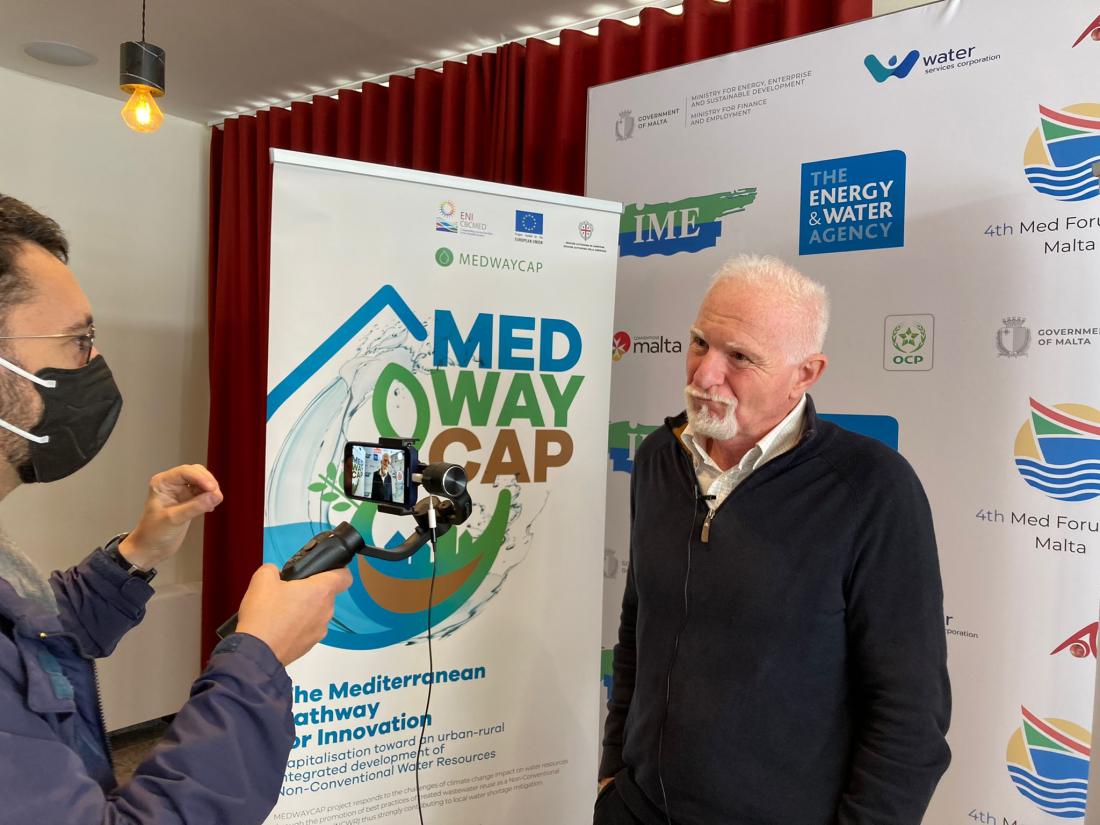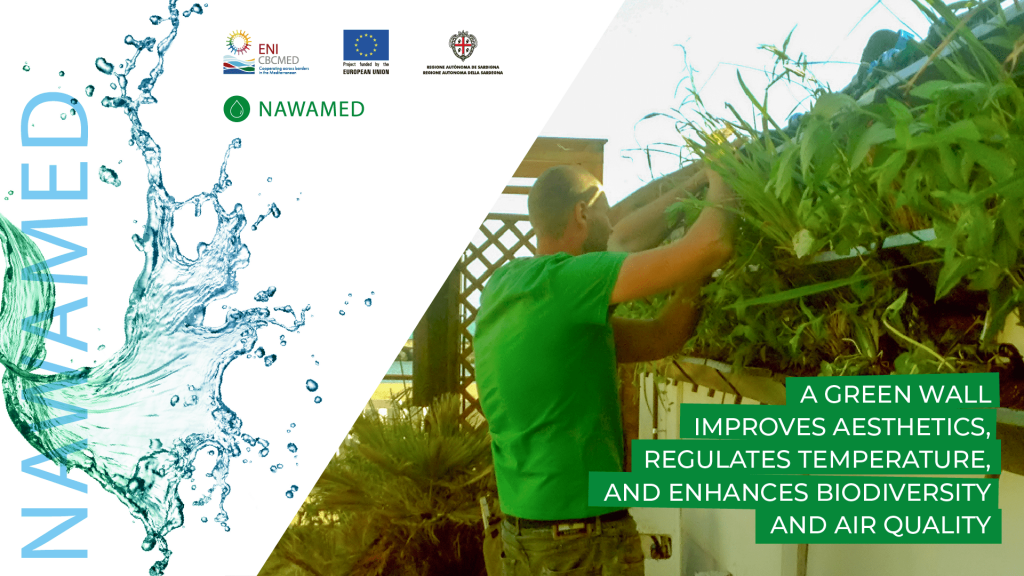NAWAMED: “It’s important to retain every drop of water the closest to the point in which is produced”, interview to IRIDRA’s Technical Director, Mr. Fabio Masi

The Euro-Mediterranean Centre for sustainable development– SVI.MED, partner in NAWAMED and MEDWAYCAP projects, attended the 4th Mediterranean Water Forum (MWF) in Malta last December to share its knowledge and establish new connections with potential international partners. A set of interviews with a number of speakers were conducted during the event to identify ways to promote innovative solutions and technologies that can improve water efficiency, starting with the reuse of treated wastewater.
The MWF has been organized by the Water&Energy Agency - EWA of Malta, partners with SVI.MED in both projects, the Institut Méditerranéen de l’Eau - IME and the Union for the Mediterranean– UfM.
IRIDRA is a partner of NAWAMED project. It is an engineering and consultancy company with almost twenty-five years of experience made up of a multidisciplinary group of professionals, able to carry out all the activities related to the analysis, planning, design and assistance in the implementation of interventions on water and environmentally sustainable management of water resources. In particular, IRIDRA has been recognized for years as a leader in the fields of nature-based solutions (NBS) and green-blue infrastructure, such as constructed wetland systems, sustainable urban drainage (SuDS), ecosystem services and climate change adaptation and mitigation.
Fabio Masi, an Environmental Chemist, is IRIDRA’s Technical Director and Founding Partner:
There is an urgency for dealing with non-conventional water resources.
The main reason is that the water scarcity issue is something which is widely spread over all the planet and especially in the Mediterranean area, where are all the southern countries will be subjects in a few decades to very long drought periods and the drought periods are then joined to more frequent flooding events, so the increase of the flooding risk in the wet period, and so on...
Even the distribution of water on the planet with the climate change effects will become even less even, and therefore water is needed by everybody. There is a minimum level quantity of water that is needed by every human on the planet, and therefore for all the situations in which good water sources are - or will not be - available in the next future, we have to think to different methods to provide this vital resource to everybody.
The weaknesses in this issue are both technical and social, regarding the adoption of them by the private users. Also, authorities are involved, because they have to allow those approaches. The technicality is mainly related to still unknown performances of some of these technologies.
I'm talking for instance about the recycling of grey water, which is a very interesting source for close looping the water at a building level. If you're able to make easily the grey water segregation, then there are already technologies which are able to treat this grey water at domestic level.
But the ones which are surely already working fine are consuming lot of energy, and they are very expensive, which is meaning that if we only go in that direction in terms of high-tech adoption, we are excluding a big part of the humanity, that will never be able to afford this kind of expenses for producing their alternative source of water. They will remain with the few taps water that they have, at the cost of the water in their country.
The solution to this is to go towards instead more sustainable technologies, like for instance the Nature Based Solutions and that’s why in NAWAMED we are experimenting "green walls" for treating the grey water.
And still the level of the technology is at a very developing phase. I mean this kind of installations are the first in the world with that scale. We are just shifting from the lab-scale experiments which are conducted in a university or research institute, and we have very few applications in the planet at a full scale and this pilots that we are realizing in NAWAMED will be the references for the next generations, for better understand how these green walls can work in a practical way in the climate in which we are going to install them.
It is also needed to find spaces for these Nature Based Solutions for treating grey water, which are not making use of a very high footprint on the ground, but normally are needing much more area in comparison to the technologies which are making use of energy for speeding up the processes, and it's quite rare in very dense urban settlements to have these spaces available. That's the reason why we are talking about green walls for instance: a wall is a surface that was not used before for that kind of usage. (Discover the first installation realized in Sicily clicking here).
And we are also thinking to make use of roofs: especially we started thinking to this kind of technologies because we were working in India where the urban settlements are really dense, and it is really difficult to find square meters on the ground where to develop services for the population living there.
It's a sort of recovery of unused spaces. It’s trying to green the cities, which is more than the first target - which is purify the water and recycling it -. There can be a lot of other different side benefits, like for instance saving energy for cooling and heating the building, which is better isolated by this kind of external walls, which are creating a barrier preserving the quality of the wall itself -so that the lifetime of the building itself will last longer- And there are benefits in terms of the energy exchanges inside.

If we put a lot of green around the city, we can have a lot of good effects in terms of micro climate, and so for instance where we have the "heat islands" in the cities which are nowadays quite well identified, we can just reduce those heat peaks by the installation of this green, which is needing water.
Incorporating “new green” in the cities is also meaning that we have to find a way to irrigate and fertilise this green and that's another reason for dealing with NWRM (“Natural Water Retention Measures”, ed.), because those can be exactly the source of “new water”, by treating and reusing the urban wastewater.
It’s important to retain every drop of water the closest to the point in which is produced: if it is rain, we just try to keep it when it's falling; if it is wastewater, we are just trying to close loop it in the building itself.
It's like 30 years that I'm working in the sector of the Nature Based Solutions, and the first resistance we are finding everywhere in the planet in terms of adoption of the technology is the lack of awareness about the technology itself. What happens is that at academic level, even though we have now about 30 years of story -which is meaning tens of thousands of peer-reviewed papers, scientific literature and so on- still in the academies they are not teaching this kind of approaches, and they are just going with the business-as-usual model, which is the use of the known technologies that have been adopted in the last 30 years. So, the first step that I think it's really the mandatory one is to force the adoption in the academies even training the teachers themselves about these new approaches for the water management.
Once we have well trained people going out of the universities. The positions they will cover will probably produce good effects in terms of a wider adoption. The other point is the economic one. A big issue is that in most of the countries we are paying water by a political mediation of its price.
We are normally not paying the water enough in terms of what are the real costs for providing water with a good quality in all the houses. There are really few countries in Europe where one cubic meter is paid more than five Euro, while the rest of Europe is instead paying around one or two Euro per cubic meter, and that's not enough for covering all the technical costs. The disadvantage of this is mainly when you have to invest:
If you leave a family to invest on its own system for looping the grey water, for recycling the grey water, inside the building, they will have to invest a few thousand Euro for the installation.
And if the payback time is too long (like 15 years), it will be really difficult to convince a family to put out from the pocket a lot of money all on a sudden, for then getting it back in 15 years, and then starting having some gains afterward.
Normally is quite difficult for the investors to think to a good investment with a so long payback period. And therefore, strategies subsidizing this kind of installations, in order to shorten the payback time, it could be really the good engine that is promoting the adoption of the technology. So most probably a subsidizing phase is needed in the beginning for starting. a wider approach.
Then the market should do the rest.
Watch a clip of the video interview here.
The MWF enabled both NAWAMED and MEDWAYCAP projects to gain a better understanding of the pathway to strengthen the value and impact of innovative integrated Non-Conventional Water Resources management solutions through a Mediterranean Alliance for a collective learning towards effective policies and innovation processes.
The debate will be continued in Syracuse (Sicily) during the event organized by SVI.MED. and EWA in the context of NAWAMED project, from the 3rd to the 5th of October, involving the main actors at Mediterranean level to compare opinions about “Mediterranean green transition toward climate change adaptation and circular water management”
Stay tuned!









